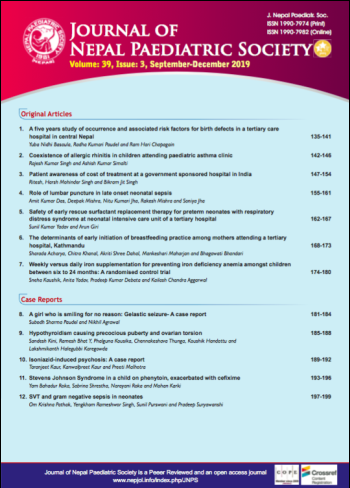Stevens-Johnson Syndrome in a Child on Phenytoin, Exacerbated with Cefixime
DOI:
https://doi.org/10.3126/jnps.v39i3.24998Keywords:
infection, muco-cutaneous disorder, phenytoin, Steven-Johnson Syndrome, toxic epidermal necrolysisAbstract
Steven Johnson syndrome and toxic epidermal necrolysis are rare but potentially life threatening muco-cutaneous disorders. Their incidence ranges from 1.2 to six per million patient-years for Steven Johnson syndrome and 0.4 to 1.2 per million patient-years for toxic epidermal necrolysis. Drugs are the primary cause for these syndromes in majority cases. They might also be due to infections with Mycoplasma Pneumoniae or Herpes Simplex. The mortality ranges from five to 40% in these cases. We report a 10-year old girl who presented with history of multiple skin eruptions involving whole body and oral ulceration for five days. She was a known case of seizure disorder on phenytoin and had been prescribed Cefexime for fever. She was managed with intravenous fluids, corticosteroids, opiates, antacids and topical antibiotics. We want to highlight the possibility of Steven Johnson syndrome following the combination of these two drugs.
Downloads
Downloads
Published
How to Cite
Issue
Section
License
Authors who publish with this journal agree to the following terms:
Authors retain copyright and grant the journal right of first publication with the work simultaneously licensed under a Creative Commons Attribution License that allows others to share the work with an acknowledgement of the work's authorship and initial publication in this journal.
Authors are able to enter into separate, additional contractual arrangements for the non-exclusive distribution of the journal's published version of the work (e.g., post it to an institutional repository or publish it in a book), with an acknowledgement of its initial publication in this journal.
Authors are permitted and encouraged to post their work online (e.g., in institutional repositories or on their website) prior to and during the submission process, as it can lead to productive exchanges, as well as earlier and greater citation of published work (See The Effect of Open Access).



